With bear populations rising, wildlife agencies are working to avoid any negative interactions with humans.
Blog Archives
Scientists Go to Bat for the Bats

Scientists engaged in the years-long battle against the devastating white-nose syndrome have found bright spots in the fight to protect bats from the disease.
Caught red-handed! Or more accurately, red-beaked

Wood thrushes — and their appetite for bright-red ginseng berries — are helping the plant spread its range further north.
New Studies Look at Southeast, Climate Change
Scientists gained new insight into how effectively forests capture carbon dioxide and mitigate climate change, and changing weather patterns may bring more tornadoes to the Southeast.
The Lake Sturgeon: Ancient Fish, Modern Recovery

The lake sturgeon is the largest and longest-living freshwater fish native to the southeastern United States. In evolutionary terms, this primitive fish has changed little since it swam among dinosaurs, but its continued survival was in doubt until recently.
An Early Warning for the Birds
Scientists noticed a group of golden-winged warblers in northeast Tennessee fleeing an approaching tornado — while the tornado was still 250 miles away.
Brook Trout Brought Home
By Barbara Musumarra Little Stoney Creek in the Cherokee National Forest is once again teeming with Southern Appalachian brook trout. This fall, the Tennessee Aquarium Conservation Institute released 1,100 of the fish into their native waters. Researchers will track the…
Forest Fugitives

Wanted: Six invasive species accussed of trespassing on American soil and robbing her of her natural resources.
A Science of Responsibility:
Dr. Ben Stout’s Dedication to Community-Based Research By Brian Sewell Dr. Ben Stout, a stream ecologist and professor of biology at Wheeling Jesuit University in West Virginia, is as at home in nearby communities as he is in the classroom.…
The Forest’s Bread and Butter

By Chris Samoray Bring down the mast. But hold on seafarers, leave the sails flying. In the forests of Appalachia, this lingo doesn’t refer to sailing. Instead, it’s used by outdoor folk to describe the fruits of plants and trees,…

